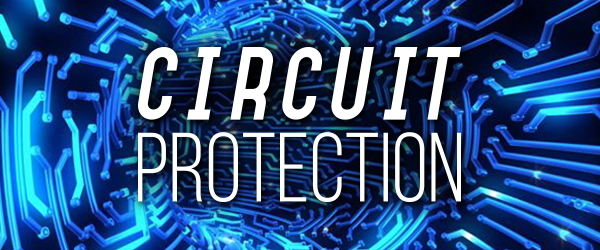
Circuit Protection: A Vital Component of IoT Infrastructure
The Internet of Things (IoT) has the potential to positively impact all industries and applications. And as the world continues to move towards large-scale implementation of IoT, the benefits are far-reaching. By connecting disparate devices into a “smarter network,” users and organizations gain ready access to real-time data analytics which can lead to better decision making and productivity. However, the infrastructure that is put in place to support IoT is fundamental to the technology’s success. Threats to the infrastructure, such as risks of system failure from environmental conditions, are real and bear consideration. In this article, we will show why circuit protection is an essential element to maintain the high level of system reliability expected of IoT infrastructure.
IoT Circuit Protection
As IoT grows in usefulness and popularity, more and more devices are becoming connected to IoT. In turn, this increases the risk of system failure from various overcurrent, overtemperature, electrostatic (ESD) and electromagnetic pulse (EMP) threats. For these reasons, proper circuit protection is necessary to reduce damage to these always-on, smart devices.
As smart cities become an ever-present reality, administrators’ concerns boil down to two major camps: the reliability and availability of valuable data. Eventually, the IoT’s interconnected devices associated with Smart Cities, concerning power generation, smart-grid management, energy and security, must not only have significant longevity, but also be able to operate autonomously. With high network connectivities subject to environmental threats, such as transient bursts or ESD occurrences, it is vital for IoT systems to maximize circuit reliability and protection through innovative advanced surge and circuit protection designs.
It may come as a surprise to many consumers that the energy efficiency, reliability, and product lifespan of IoT integrated devices are a direct result of precise circuit design. Designers, therefore, face a significant challenge (and have a significant opportunity) to improve upon current design standards to increase system reliability. To maintain the high-level of reliability expected of IoT technology, circuit protection is critical, and continuing the reputation of reliability will influence the adoption and expansion of the IoT ecosystem.
Where Circuit Protection Makes a Difference
Predictively, the large-scale adoption of IoT will elicit a high demand for circuit protection technologies. Why? With an increasing network of interconnected, smart devices, the consumer populous and operational infrastructure who rely on available, reliable access to data will put high pressure on the functionality of everyday devices and technologies. For example, if members of a smart city depend on a smart grid or intelligent transportation application for their daily travel requirements, they will anticipate it performs with extreme reliability, and without the threat of data failures.
Further, regarding the gradual emergence of “smart cities,” there’s significant room for growth and development. Smart cities are slated to have autonomous, IoT integrated infrastructures such as traffic signals, street lighting, and industrial controls – in fact, we see some of these technologies in place today. To implement these technologies, they will require efficient monitoring devices for power generation, traffic control, smart-grid management, energy, and security.
Part of this efficient monitoring comes into play with thermal management. Connected devices are vulnerable to over-temperature. Infrastructure designers must build-to-protect sensitive devices. They can be hardened to withstand harsh external environments or the enclosures housing them can provide a more stable environment. Subsurface mini-vaults offer a more stable environment as well as additional room for equipment designed specifically to protect circuits from overcurrent, pulses, etc. These circuit protection devices protect vital equipment from electrical transient threats that arise from environmental outliers; ESD and transients such as lightning or bursts. By addressing circuit protection and environmental issues such as temperature and pulses, data will continue to flow uninterrupted to all IoT-supported devices.
IoT Ecosystem Circuit Protection
For IoT infrastructure to work properly, there must be secure connections between the sensing nodes and the hardware in a computing platform. Electrical transients caused by power surges, lightning strikes, or “dirty power” can cause these sensitive connections to fail. There are several circuit protection solutions that can meet the needs of different types of devices in the IoT ecosystem.
For example, Surge Protective Devices (SPDs) employ modules for harsh computing environments and customized magnetics and trimmers to support efficient power management. High-Speed Protectors (HSPs) offer data line protection and requires low conductive in-circuit protection.
As a final example, TCOs, or lithium-ion battery packs with miniature thermal cutoffs, provide accurate and repeatable overcurrent and overtemperature protection. This type of circuit protection has particular considerations when it comes to mobile devices, and designers must consider the specific space constraints of this type of device.
Designers are tasked with considering circuit protection from an early point in the design phase. To help ensure IoT-enabled systems operate to their fullest, circuit protection must continue to be a priority. As our world continues to be interconnected, efficient circuit protection is at the forefront of consumers’ minds. By providing superior circuit protection, designers will take away one of the largest concerns in consumer’s minds about system reliability.
Luckily, there is a broad selection of proven and advanced circuit protection solutions at designer’s disposal, and integration with these systems will help city planners and IoT designers achieve the real-time information access that is foundational to the Internet of Things. Space to house circuit protection solutions can reside above ground or subsurface. In densified areas, the subsurface option is growing as a more appealing solution due its higher level of security, unobtrusiveness and more space to house circuit protection equipment and battery back-up. Mini-Vaults under ADA ramps offer cities to create space that meet these demands.

